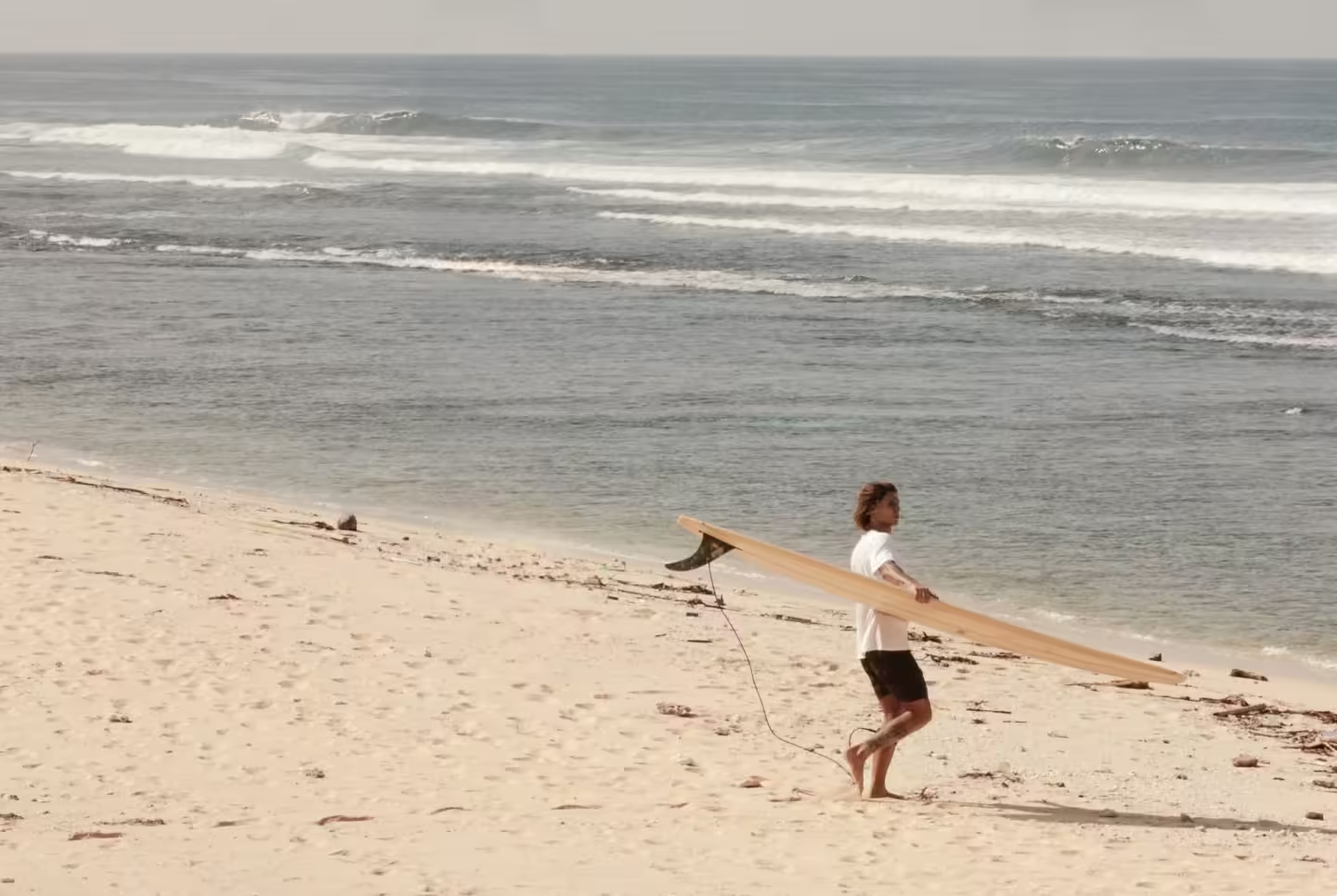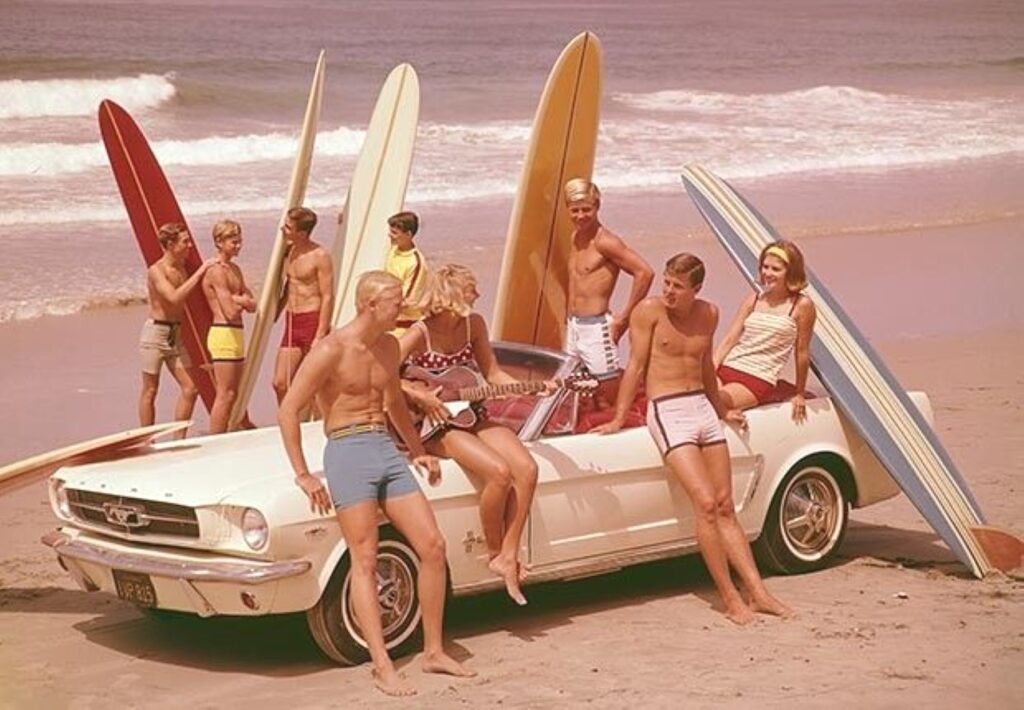The History of Surf Fashion and Evolution of Surf Culture
Surf fashion has come a long way since its humble beginnings in the early 20th century. From the classic sweaters and boardshorts popularized by surf legends to the colorful neoprene wetsuits and bold graphic tees of today’s surf culture, surf fashion has always been a reflection of the surfing lifestyle and the surfers themselves.
With roots in the sun-soaked beaches of California and Hawaii, surf fashion has spread its influence across the globe and continues to evolve as surfing grows in popularity.
With its rich history, iconic looks, and innovative designs, surf fashion is more than just a way to stay warm on a chilly beach day or to expose your stoke vibes with that graphic tee.
The surfer clothing style is a way of life, a symbol of freedom and adventure, and a true expression of the surfing spirit.
Let’s explore the exciting history of surf fashion, from its early days in the 1950s to today’s cutting-edge trends.
Complete your surfer look and elevate your style with unique masterpieces.
Surfcasual offers the ultimate collection of comfy surfer’s t-shirts that perfectly blend class and stoke.
Explore our exclusive collection here.
The Beginnings of Surf Fashion — Mid-1930s
Surf fashion can be traced all the way back to the 1930s when Hawaiian shirts made their debut in mainland America.
The bright prints and styles were inspired by island culture and quickly gained in popularity as tourists flocked to Hawaii for vacations.
Even though the prints Hawaiian prints were colorful, surf fashion at that time was all about keeping it simple and functional.
With their classic style and timeless appeal, these early surf fashion staples set the tone for decades of surf style to come.
An Era of Freedom — 1950s-60s
The 1950s and 1960s saw the birth of surf culture as we know it today, with the rise of a more colorful and playful surf fashion that celebrated the sunny, aloha spirit of the era and the rise in popularity of surfing alongside rock n’ roll music.
A well-known band in this sphere is, of course, The Beach Boys, which popularized a more laid-back style featuring Hawaiian shirts, shorts, sandals, swim trunks, and volley shorts.
That style was casual and relaxed, consisting of brightly colored, and this combo became known as “surfer style” which was adopted by young people everywhere who wanted to emulate the carefree lifestyle of California beach bums.
Another influence on surf fashion at that time was movies like “Gidget” and “Beach Party” which featured young, attractive actors and actresses sporting bright swimwear, colorful Hawaiian shirts, and fun accessories like sunglasses and sandals.
These films helped to popularize surf fashion around the world. With its bold prints, vibrant colors, and fun-loving attitude, 1950s surf fashion was all about embracing the joys of beach life and soaking up the sun.
In the 1960s, surf fashion began to evolve once again with brands such as Billabong and Quiksilver emerging on the scene.
While, believe it or not, Jack O’Neill made history as the mastermind behind the first ever wetsuit designed specifically for surfing.
With his innovative design, he combined the classic vest silhouette with neoprene material to create a garment that not only kept surfers warm but also protected them from the elements.
This game-changing invention has since become an all-time classic, paving the way for the modern-day wetsuits that we know and love today.
This decade saw bolder trends emerge — bright colors and checkered prints were all the rage among teenage girls while boys opted for simple yet eye-catching designs on t-shirts featuring everything from white tigers to palm trees.
As surfing grew in popularity throughout this period, so too did its associated style with more companies releasing clothing lines dedicated solely to surfers which included everything from board shorts to rash guards.
The Groovy Decades — 1970s-80s
In the 1970s, brightly colored boardshorts with fun patterns started to become popular, and surfers began to accessorize with items like bandanas and headbands.
Surf fashion also became more gender-specific, with girls wearing denim cutoffs and tank tops, and guys sporting Hawaiian shirts and shorts.
At that time, surfers began to form their own unique style — sweaters and jeans, checkered Vans slip-ons, and white t-shirts were all common.
The 1980s saw a shift away from loud patterns towards more muted tones and retro vibes. Preppy styles such as boat shoes and madras plaid shorts were popular among surfers who wanted to look polished but still maintain their cool factor on the beach.
Women’s swimsuits at this time featured high-leg cuts, high waists, halter tops, and mesh detailing for an extra touch of feminine flair.
From the Beach to the Streets — 1990s-00s
In the 1990s and ’00s, surf fashion somewhat took a semi-evolution as streetwear became more popular among surfers.
Back in the 90s and 2000s, wearing surf clothes wasn’t just limited to hitting up your local beach break. It became acceptable and fashionable to wear those same brands when you weren’t even near a beach.
Companies like Stussy emerged as pioneers in this new style; instead of relying on traditional surf brands for their clothes, surfers now had access to modern designs inspired by hip-hop culture.
This was also when skateboarding first made an appearance in surf culture; skate brands like Vans helped bring streetwear into mainstream fashion.
Since skateboarding become more mainstream and influenced surf culture; sneakers were now paired with board shorts instead of flip flops; hoodies were layered under zip-up jackets; caps became a staple accessory; and graphic tees featuring logos from streetwear brands were everywhere you looked.
Denim shorts were paired with cropped tees for a relaxed yet stylish look, often featuring eye-catching prints.
This style of dressing was characterized by its layering, as it was common to see hoodies over tank tops or t-shirts under jackets for an extra pop of color.
It was a way of expressing personal style while connecting with others who had similar interests in beach culture.
These subtle changes allowed surf fashion to evolve into something much more than just beach attire — it became an aesthetic all its own that could be worn anywhere at any time and surfwear become more versatile for everyday wear.
Surf fashion in the 1990s and 2000s is the most identical and a lot like what surfers like to wear today.
The Modern Surfer — Today’s Surfwear Trends
Today, surf fashion is more diverse and inclusive than ever before. While the essence of surf culture remains the same, surf fashion has evolved in a certain way that reflects the changing times and advancements in technology.
Today’s surf fashion is all about striking a balance between performance and style and embracing a more modern, inclusive approach to surfwear.
From the beach to the street, surfers are incorporating elements of surf culture into their daily fashion choices, creating a unique and eclectic style that is all their own.
In addition, there are many smaller indie brands popping up around the world that focus solely on creating functional yet stylish apparel specifically designed for water sports enthusiasts — perfect for those who want to stand out from the crowd while still feeling comfortable.
Whether it’s vibrant tie-dye patterns, bohemian styles, or retro-inspired classic boardshorts, there are countless ways to express your love of surfing through style.
Surf fashion continues to evolve as a reflection of the surfing lifestyle, surfers, and the people who wear it — no matter where or when you live or surf.
Conclusion
Surf fashion has come a long way from its days in Hawaii and then to California during the 1960s and ’70s.
It has evolved from humble beginnings into what we see today — a combination of traditional surfer looks mixed with elements from streetwear culture.
Whether you prefer classic board shorts or modern streetwear designs, there’s something out there for those who live the surfing lifestyle.
It’s not just functionality, it’s a way to spread a message.



